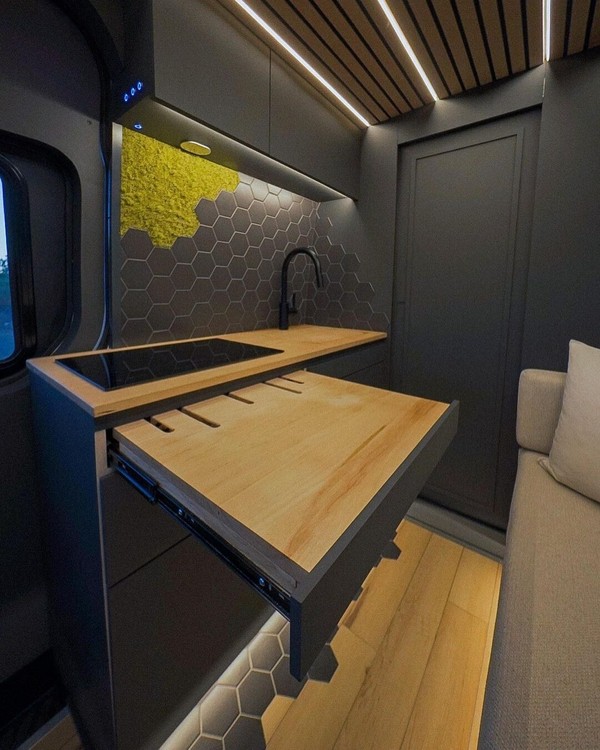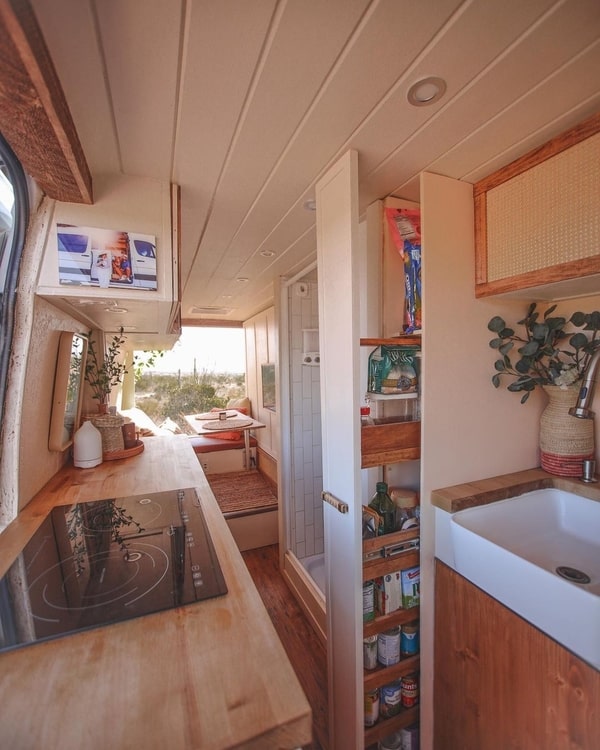Fewer dependencies make van life much more convenient. Induction or propane are the final candidates in most cases for cooking options.
Some are desire to have an all-electric van built for simplicity. You can cut down an additional fuel source and depend on the house battery system since induction cooktops run on electricity.
But the question is whether this house battery system is enough to support induction cooking energy needs.
I will explain a few facts about battery usage around induction cooking. I hope this might be helpful for you to make the right decision.

Most induction cookers come in the watts range from 800 to 2100. They come in the form of a portable or stationary unit. Some are single burners, and some are dual burners.
Single or dual burner 1800W induction cookers are among the most popular choices. The double burner cooktop will share the 1800W between two burners.
There are induction cookers that produce more than 3000W power output. But those not suited for van build most of the time. More power consumption means you need a bigger inverter to convert DC to AC and a more extensive house battery system to support it.
Table of Contents
How to decide inverter size
The house battery system is 12V, and the induction cooktop runs 110V. An inverter needs to convert this 12V to 110V. But inverters are not run on 100% efficiency.
There is energy lost when converting DC to AC. This well-known Victron Multiplus 12/3000/120 inverter charger has 93% max efficiency. That means the inverter roughly draws 108W to produce 100W output.
It is advisable to calculate the inverter to draw a minimum of 10% watts additional than the actual appliance usage considering all other losses due to wire gauge and wire length.
Induction cooktop maximum watts = 1800W
Inverter may draws extra 10% = 1800W X 1.1 = 1980W
The above 1980W power is drawn from the battery bank only when the 1800W induction cooktop runs on its highest setting. The highest setting gets used most of the time only for boiling water. Typically power setting between 800W to 1400W is used for cooking in most cases.

Another critical factor to note is electric pulsing. Electric pulsing is a change of current intensity in a short period. Power usage goes up and down when an induction cooktop uses in a medium setting.
Let’s say the power setting sets for 1000W. Still, the actual usage of the induction cooktop will change continuously between the 500W and 1350W range.
When you refer to the watts of an inverter, typically mention by its average output like 2000W, 3000W. It also has another two values saying continuous power and peak power.
The inverter can supply this peak output power for a brief period. Continuous power is the long-term operation output that the inverter can supply without any adverse effect.
Victron Multiplus 12/3000/120 inverter(3000W) rated as 6000W for the peak usage and 2400W for the continuous output at 77 degrees Fahrenheit.
Victron Multiplus 12/2000/120(2000W) inverter rated as 4000W for the peak usage and 1600W for the continuous output at 77 degrees Fahrenheit.
It is crucial to consider this continuous power value when deciding the inverter capacity. You may experience fuse tripping when you start to use other 110V appliances while using the induction cooktop if the inverter fails to cater to continuous power demand.
The wise decision is to go with a 3000W inverter if your choice is a 1800W induction cooktop. 3000W inverter has a continuous output rate of 2400W. So you have the freedom to use other 110V appliances simultaneously without any issue.
How much battery bank do I need?
Absorbent Glass Mat (AGM) or Lithium iron phosphate (LiFePO4) are commonly used for energy storage in van builds. Earlier AGM batteries dominate this, and now LiFePO4 is getting traction due to various benefits over AGM.
Induction cooktops are power hunger appliances. It may consume from 800W or more based on the equipment and usage. It usually takes 10 to 20 minutes to prepare a meal (This can be vary based on your diet) and might use once or twice per day.
The power consumption of appliances mentioned in watts and battery storage capacity is in amp-hour(AH). A single 100AH battery produces up to 1200Wh (1200W for an hour), assuming the battery can discharge 100% of its power and no conversion loss in the inverter.
100AH X 12V = 1200W
But in reality, this is a bit different story, especially with AGM.
First, AGM can’t discharge up to 100%. Recommended battery discharge rate for AGM is 50% of the capacity for the longevity of the battery life.
Second, recommended continuous discharge current rate for AGM is 0.2C or 20AMP per hour. Exceeding this will damage your battery in the long run and reduce the usable battery capacity.
Compared to the AGM, LiFePO4 can discharge up to 100% of the capacity and produce a continuous discharge rate of 1C. But if you are expecting extended battery life as it’s advertising, try to keep the discharge rate under 0.5C and don’t discharge below the 15% of usable battery capacity.
AGM batteries are not suitable for use with power-hungry appliances like induction cooktops. One reason is that AGM batteries can’t discharge energy at a high rate for a more extended period.
Usable battery capacity reduces drastically when this happens and can affect the battery’s durability if this happens too often.

Battle Born and Renogy are among the leading LiFePO4 battery brands, and those batteries are well suited to use with induction cooktops.
Let’s say the induction cooktop use 1800W on the highest setting. The inverter needs to draw 1980W from the battery bank by assuming DC-AC conversion efficiency is 90%.
So this means the battery bank needs to supply 165AMP (1980W / 12V). As I explained earlier, a 100AH single LiFePO4 battery can produce a 100AMP continuous discharge current for one hour.
So a minimum of two 100AH LiFePO4 batteries needs to start the induction cooktop.
80% of the battery power will drain if the induction cooktop uses a maximum setting of 1 hour. 40% if used for 30 minutes. 2.75 amp per minute, in other words. 41.25 amp will use if the induction cooktop uses for 15 minutes in maximum power configuration.
In theory, this is double with 2 X 100AH LiFePO4 batteries. But the battery bank will be under stress since the discharge rate is relatively high. Even though LiFePO4 supports a 1C discharge rate, the manufacturer advises using under 0.5C for the battery’s longevity.
4 X 100AH LiFePO4 battery bank recommends a 1800W induction cooktop by considering the above factor.
100AH battery from Battle Born can surge 200AMP for 30 seconds. But that doesn’t help with the induction cooking since that is for a short period, and continuous battery loading with high amp discharge may affect battery performance.
Advantages of Cooking on Induction Cooktop
The leading blocker for moving the induction cooktop is the cost of a larger battery bank. It may require up to 100AH additionally based on your diet. But why you should consider fitting an induction cooktop if the budget permits.
- No use of propane
There should be additional safety precautions if the propane tank is on board. Lots of these concerns can eliminate if the propane tank can mount undercarriage. But still, you need a propane detector. - Moisture/other harmful gas
Water vapor/stram can release from meals while cooking, which is unavoidable. But top of that, propane burners can generate water vapors and other harmful gases. Harmful gases (carbon monoxide, formaldehyde, etc.) can release due to the burning process and the impurity of the propane tanks.
